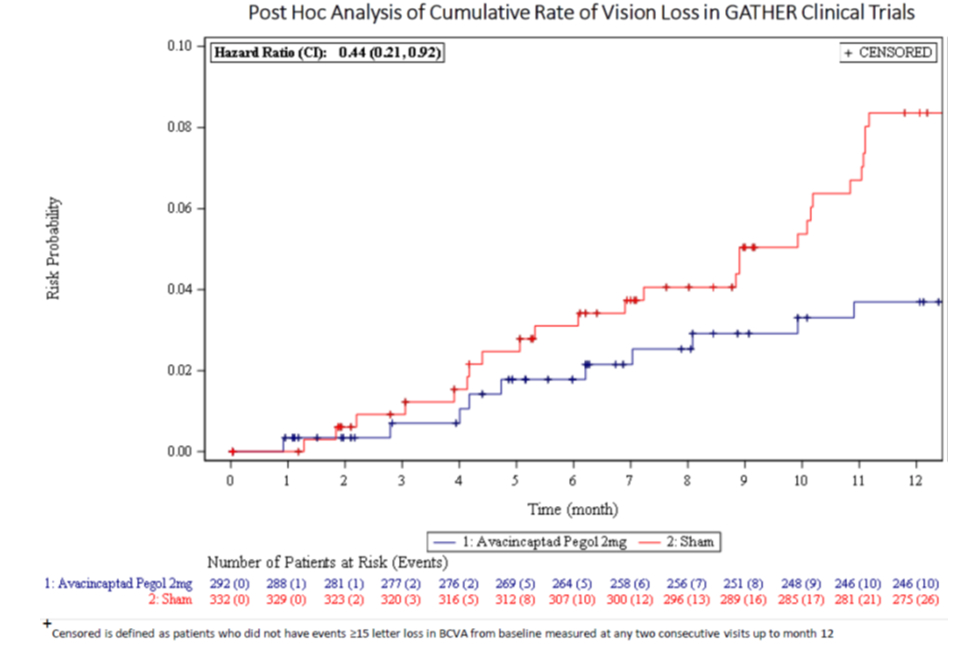Iveric Bio releases data in geographic atrophy from avacincaptad pegol GATHER trials
According to the company, post-hoc time-to-event analysis signals up to 59% risk reduction in rate of vision loss compared to sham treatment at 12 months. The analysis will be presented at the ARVO Annual Meeting from April 23-27 in New Orleans.
ACP is an investigational drug for treatment of GA secondary to AMD that is currently under evaluation for safety and efficacy by the FDA. (Adobe Stock image)

Iveric Bio Inc. this week announced an exploratory time-to-event analysis from the avacincaptad pegol (ACP) GATHER clinical trial program evaluating reduction in vision loss with ACP 2 mg versus sham treatment.
The company noted that its GATHER1 and GATHER2 clinical trials were designed to evaluate the rate of geographic atrophy (GA) lesion growth in patients with GA secondary to age-related macular degeneration.
ACP is an investigational drug for treatment of GA secondary to AMD that is currently under evaluation for safety and efficacy by the U.S. FDA. ACP is a novel complement C5 protein inhibitor. Overactivity of the complement system and the C5 protein are suspected to play a critical role in the development and growth of scarring and vision loss associated with GA secondary to AMD. By targeting C5, ACP has the potential to decrease activity of the complement system that causes the degeneration of retinal cells and potentially slow the progression of GA.
According to the company, the post-hoc analysis for vision loss from these pivotal studies signals up to a 59% reduction in rate of vision loss with ACP 2 mg compared to sham treatment at 12 months. Vision loss in this analysis was defined as a loss of ≥ 15 letters (EDTRS) in best corrected visual acuity (BCVA) from baseline measured at any two consecutive visits up to month 12.
This analysis will be presented at the upcoming Association for Research in Vision and Ophthalmology (ARVO) Annual Meeting April 23-27 in New Orleans.
The company noted ACP met its primary endpoint in the completed GATHER1 clinical trial and the ongoing GATHER2 clinical trial, both of which are randomly assigned, double-masked, sham-controlled, multicenter Phase 3 clinical trials. These clinical trials evaluated the safety and efficacy of monthly 2 mg intravitreal administration of ACP in patients with GA secondary to AMD.
For the first 12 months in both trials, patients were randomized to receive either ACP 2 mg or sham monthly. There were 286 participants enrolled in GATHER1 and 448 participants enrolled in GATHER2. The primary efficacy endpoints in both pivotal studies were based on GA area measured by fundus autofluorescence at three time points: Baseline, Month 6, and Month 12.
The mean rate of growth (slope) in GA area from baseline to month 12 using observed data was 35% in GATHER 1 and 18% in GATHER2. In GATHER1 and GATHER2 combined, the most frequently reported treatment emergent adverse events at 12 months in the 2 mg recommended dose were related to the injection procedure. The most common adverse reactions (≥ 5% and greater than sham) reported at 12 months in patients who received ACP 2 mg were conjunctival hemorrhage (13%), increased IOP (9%), and CNV (7%).
According to the company, results were consistent in the GATHER1 and GATHER2 clinical trials independently, signaling a 44% reduction (Hazard Ratio0.56 with 95% CI, 0.15-2.06) and a 59% percent reduction (Hazard Ratio 0.41 with 95% CI, 0.17-1.00) respectively in the rate of vision loss with ACP 2 mg compared to sham over the first 12 months of treatment.
In a combined analysis of GATHER1 and GATHER2 shown in the accompanying graph, patients treated with ACP 2 mg experienced a 56% reduction (Hazard Ratio 0.44, with 95% CI, 0.21-0.92) in the rate of vision loss compared to sham over the first 12 months of treatment. This post-hoc analysis evaluates the potential vision loss signal through 12 months of treatment and is exploratory in nature.
Arshad M. Khanani, MD, MA, FASRS, managing partner and director of Clinical Research at Sierra Eye Associates, Reno, Nevada, pointed out that GA is a devastating disease, which can lead to vision loss and irreversible blindness taking away the patients’ ability to drive, read and see their loved ones.
“On average, it takes 2.5 years for GA lesions to start impacting central vision1,” he said. “Early treatment effect has the potential to change the trajectory of disease for patients. A reduction in rate of vision loss with ACP 2 mg of up to 59% compared to sham treatment at 12 months supports the clinical relevance of the GATHER1 and GATHER2 primary endpoint, which met statistical significance.”
References
- Lindblad AS, et al, and AREDS Research Group. Arch Ophthalmol. 2009;127(9):1168-1174

Newsletter
Keep your retina practice on the forefront—subscribe for expert analysis and emerging trends in retinal disease management.